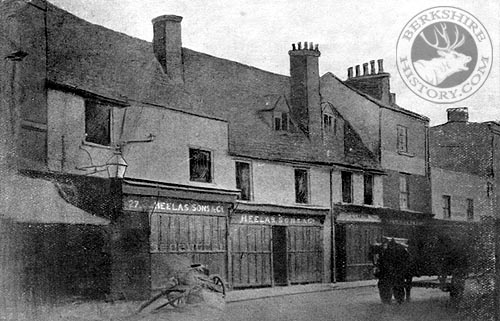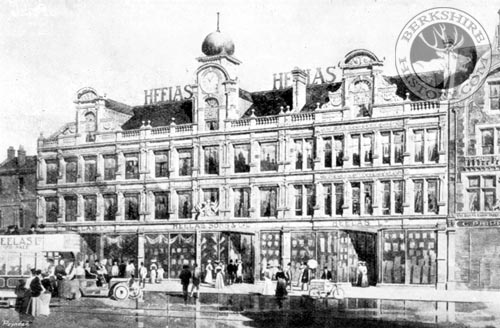 |
 |
|||
|
|
The Heelas family started out with a drapery business in Wokingham. On 1st May 1854, John Heelas (1804-1884) and his sons, John Junior (1826-1910) and Daniel (1831-1910), opened a second shop at 33 Minster Street in Reading, just off the corner of Chain Street. The business specialised in linen and silk, but the number of employees did not exceed ten. Business was swift and, within three years, the shop had expanded into the building next door at No. 32. The Royal Warrant was gained in the same year. In 1866, the old chapel buildings occupied by the Primitive Methodists were purchased by the firm and it was at this time that the carpet and cabinet departments were added. In 1870, the next step of importance was the purchase of the "Black Boy Inn" at No. 111 Broad Street. A large central arcade was then built through to the Minster Street shop, to give a Broad Street frontage to the business, partially to a design by WH Woodman. By this time, the firm's activities had shifted very much towards house furnishing. arcade was fitted from floor to ceiling with a varied assortment of pieces of furniture, carpets and linoleums. Serried ranks of chairs hung from rafters and walls. In the same year the shop on the left of the Broad Street premises (No. 112) was taken on lease and opened as a gentlemen's and boys' outfitting department. In 1870, the old drapery shop in Minster Street was abandoned as the main Minster Street entrance and an extensive block was erected at Nos. 24-29 as a house for the employees, and new windows designed for the display of goods, beside extensive showrooms for drapery. In 1874, a large gallery was added to the arcade, giving further accommodation for cabinets and furniture. In 1877, No. 112 Broad Street was remodelled on contemporary lines with a new frontage. In 1881, through increased business, it became necessary to make further provisions and accommodation was acquired by taking adjoining premises, Nos. 108 & 109 Broad Street, and erecting another large block of premises. In 1883, extensive showrooms were added in the rear of 108 & 109 Broad Street for the display of cabinet furniture. In 1890, a fine three storied building was built on freehold land between Broad Street and Minster Street as cabinet and carpet workshops for in-house product manufacturing. The same year was built a large showroom on the ground floor for ladies' and children's underclothing, and, in 1898, the old drapery premises were pulled down and a fireproof depository was erected. In 1901, "The Eagle Inn" at No. 30 Minster Street and two other shops were pulled down and extensive buildings were erected, giving large space for everything necessary for house furnishing. Having bought Ferguson's old Brewery Yard next door in 1905, another block of workshops was added for cabinet making, polishing furniture and making of bedding, also as packing and despatch rooms. The Company's premises are almost entirely built on freehold ground, and that portion which is leasehold is held at a moderate rental on a long lease. In 1890, the Prince of Wales honoured the firm by appointing them linen drapers and house furnishers to His Royal Highness, the warrant being continued on his accession as King Edward VII, and, in 1892, another Royal Warrant was granted by the Crown Princess of Greece. In 1897, Heelas Sons and Co Ltd registered themselves as a limited company.
Both the founding Heelas brothers died in 1910 and, by 1937, the family had decided to sell the business. A bid by the John Lewis Partnership stalled and further thoughts of selling were postponed by the outbreak of the Second World War. During the War, Heelas' garage in Minster Street received a direct hit from a German bomb on 10th February 1943, but the department store survived intact. The firm's fire brigade also served the town of Reading admirably during this period. In 1947, the family finally sold up to Chales Clore; but the marriage was not a happy one and the business was sold again, only three years later, to the United Drapery Stores. In 1953, the John Lewis Partnership finally took over the company. They had purchased AH Bull's Drapery, across the road in Broad Street, back in 1940 and the two shops then amalgamated. The larger and more successful Heelas building was retained, while AH Bull's closed. Heelas has flourished under the John Lewis name. In 1961, there was a major refurbishment of the shop in order to create 8,500 square feet of new floor selling space. Then, in 1979, a complete rebuild of the Minster Street end of the building was initiated, the work being undertaken by the RD Cook Partnership and Sir Hugh Casson. Three phases took two years each, while the 1,100 strong staff kept the business open and still popular. The external brick facade with mighty grey slate roof dominates the Minster Street and Chain Street. New Pevsner describes it as having "faint echoes of Japan, of the Prairie School, and of the great tithe barns". Sadly, in 2001, the business was rebranded as John Lewis Reading, and the Heelas name was officially dropped after 147 years. Despite this, it will always be popularly known as Heelas by all true Readingensians.
|
|||
| © Nash Ford Publishing 2016. All Rights Reserved. | ||||





 Heelas'
of Reading
Heelas'
of Reading By 1909, the firm employed
some 300 to 400 people and the premises were largely rebuilt with a fine new
Broad Street frontage. It featured a novel arrangement of windows, forming an arcaded passage
around an 'island window', giving over 160 feet of plate glass windows for the display of new and choice goods from the various departments of the
house.
The new frontage was built of terracotta to correspond with the Woodman's portion of
the Broad Street premises at No. 110, and was considered an important addition to the Street Architecture of the town. Passing through the
arcade two handsome carved doors brought the visitor to a kind of reception
hall, where a broad central stairway, wrought in pitch pine and oak, led to
large
new showrooms, and, for those visitors who avoided stairs, an electric elevator
was provided close to the entrance. On the ground floor, an exhibition of a series of
'furnished rooms' were displayed as suggestions for laying out a house. On the same floor, a large
showroom was opened for furnishing fabrics and curtains of all kinds. The new
building was not only devoted to everything required in the furnishing of a house, but for the further development and extension of various departments, such as a
showroom for mantles and costumes, another for young gentlemen's complete
outfits and separate sections on the ground floor for gentlemen's outfitting. The handsome elevation and
high workmanship of the new building
was due to the architect, Frederick William Albury of 154 Friar Street
(Reading), and the builders, Messrs. C.
Hunt & Son of High Wycombe. The bronze shop front, glass bending and varnished mahogany work
were carried out by Haskins Brothers shopfront fitters, from the details of the architect. The
electric light installation was by Baughan & Co of 8-10 London Street
(Reading), and the electric passenger lift by Waygood & Co.
By 1909, the firm employed
some 300 to 400 people and the premises were largely rebuilt with a fine new
Broad Street frontage. It featured a novel arrangement of windows, forming an arcaded passage
around an 'island window', giving over 160 feet of plate glass windows for the display of new and choice goods from the various departments of the
house.
The new frontage was built of terracotta to correspond with the Woodman's portion of
the Broad Street premises at No. 110, and was considered an important addition to the Street Architecture of the town. Passing through the
arcade two handsome carved doors brought the visitor to a kind of reception
hall, where a broad central stairway, wrought in pitch pine and oak, led to
large
new showrooms, and, for those visitors who avoided stairs, an electric elevator
was provided close to the entrance. On the ground floor, an exhibition of a series of
'furnished rooms' were displayed as suggestions for laying out a house. On the same floor, a large
showroom was opened for furnishing fabrics and curtains of all kinds. The new
building was not only devoted to everything required in the furnishing of a house, but for the further development and extension of various departments, such as a
showroom for mantles and costumes, another for young gentlemen's complete
outfits and separate sections on the ground floor for gentlemen's outfitting. The handsome elevation and
high workmanship of the new building
was due to the architect, Frederick William Albury of 154 Friar Street
(Reading), and the builders, Messrs. C.
Hunt & Son of High Wycombe. The bronze shop front, glass bending and varnished mahogany work
were carried out by Haskins Brothers shopfront fitters, from the details of the architect. The
electric light installation was by Baughan & Co of 8-10 London Street
(Reading), and the electric passenger lift by Waygood & Co.